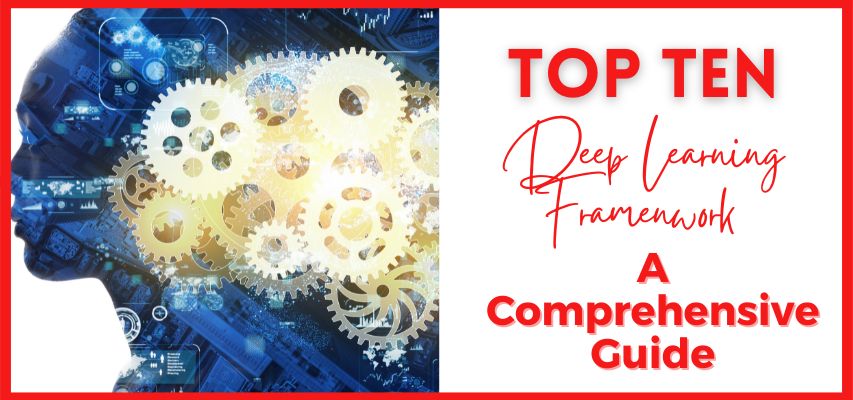In this comprehensive guide, we will delve into the world of deep learning and explore the top ten frameworks that are revolutionizing the field of artificial intelligence. From TensorFlow to PyTorch and beyond, discover the most popular and powerful tools used by experts and researchers worldwide. Gain valuable insights and practical knowledge to stay ahead in the ever-evolving world of deep learning.
What is Deep Learning?
Deep learning, a subset of machine learning, is an advanced technique that enables machines to learn from vast amounts of data and make decisions without explicit programming. Interconnected layers of nodes form deep learning models, also known as artificial neural networks, and their structure and function draw inspiration from the human brain. Each node processes and transforms the data, gradually extracting relevant features and patterns, ultimately leading to accurate predictions and insights.
The success of deep learning owes much to the availability of powerful deep learning frameworks. These frameworks are libraries or toolkits that provide a collection of pre-built functions and algorithms to simplify the development and training of deep learning models. With these frameworks, researchers, data scientists, and developers can focus on building innovative AI applications without getting bogged down in the complexities of low-level implementations.
Also, read: Top Ten Reasons To Join Stevens Applied Artificial Intelligence Course
Unleash the Potential of Deep Learning: Top 10 Frameworks to Supercharge Your Projects
Deep learning frameworks have democratized artificial intelligence, making it accessible to a broader audience. Here, we will explore the top ten deep learning frameworks that have played pivotal roles in advancing the field.

1. TensorFlow: Powering AI at Scale
TensorFlow, developed by Google Brain, is one of the most influential and widely used deep learning frameworks. It is an open-source platform known for its scalability, flexibility, and versatility. TensorFlow’s computational graph abstraction allows developers to build complex neural networks effortlessly. With support for both CPUs and GPUs, TensorFlow enables seamless scaling for both research experiments and large-scale production systems.
Also, read: Top 10 AI Myths You Should Know for 2024
2. PyTorch: Flexibility and Intuitive Interface
Facebook’s AI Research Lab (FAIR) rapidly developed PyTorch, an open-source framework that has gained popularity among researchers and academics. What sets PyTorch apart is its dynamic computational graph, which enables users to make changes on the fly during model training. This flexibility makes debugging and experimentation more intuitive. Researchers often prefer PyTorch for its ease of use and natural integration with Python, facilitating rapid prototyping and testing of novel AI architectures.
3. Keras: High-Level API for Rapid Prototyping
Initially an independent framework, Keras is now an integral part of TensorFlow and supports other backend engines like Theano and Microsoft Cognitive Toolkit (CNTK). Keras offers a high-level API that abstracts the complexities of building deep learning models, making it a popular choice for beginners and experienced developers alike. Its minimalist design and ease of use accelerate the development process, enabling rapid prototyping and experimentation with different architectures.
Also, read: Top 10 Robotic Applications: Exploring the World of Robots and Their Impact
4. MXNet: Scalable and Efficient
MXNet, backed by the Apache Software Foundation, boasts impressive scalability and efficiency, making it suitable for both small-scale experiments and large-scale production deployments. One of its unique features is its support for both imperative and symbolic programming. With dynamic computation capabilities similar to those of PyTorch and TensorFlow, MXNet offers a powerful and flexible framework for deep learning projects.
5. Caffe: Emphasis on Vision Tasks
The Berkeley Vision and Learning Center (BVLC) developed Caffe, which is known for its focus on computer vision tasks. It has gained popularity for its excellent performance and efficiency, particularly in image classification and object detection. While Caffe’s static graph nature limits its flexibility compared to dynamic frameworks, its speed and ease of use make it a preferred choice for vision-related applications.
Also, read: Unlock AI’s Potential: 10 Deep Learning Techniques in 2024
6. Theano: Pioneering Deep Learning Framework
Theano, while no longer actively developed, has a significant place in the history of deep learning. It laid the groundwork for many deep learning frameworks that followed and contributed to the development of the field. Its symbolic mathematics approach allowed researchers to define mathematical expressions and efficiently compute gradients for training neural networks. Though not as widely used today, Theano remains an essential part of the deep learning journey.
7. Microsoft Cognitive Toolkit (CNTK): Scalable and Efficient
Microsoft developed the powerful deep-learning framework, the Microsoft Cognitive Toolkit, or CNTK. With a focus on scalability and efficiency, CNTK is optimized for training large models across multiple GPUs and distributed environments. Additionally, it supports various network types, including feedforward, convolutional, and recurrent networks, making it suitable for a wide range of deep learning tasks, such as speech recognition, image processing, and natural language understanding.
Also, read: Top Ten Augmented Reality App Development Companies for 2024
8. Chainer: Empowering Research and Innovation
Chainer’s “Define-by-Run” approach sets it apart from many other frameworks. It allows researchers to define neural network architectures dynamically, facilitating rapid experimentation and innovation. Chainer’s automatic differentiation feature enables users to effortlessly compute gradients, making it easier to develop and optimize complex models. It remains a popular choice among researchers who value the flexibility of dynamically defined networks.
9. Deeplearning4j (DL4j): Deep Learning for Java
Deeplearning4j, also known as DL4j, brings the power of deep learning to the Java ecosystem. As Java is widely used in enterprise applications, DL4j offers a convenient option for Java developers who want to leverage the capabilities of deep learning in their projects. It supports distributed training and integrates with Apache Spark and Hadoop, enabling large-scale data processing and training.
Also, read: Unraveling the Top Ten Deep Learning Libraries for Neural Network Enthusiasts
10. ONNX: Interoperability for AI Models
Unlike other deep learning frameworks, ONNX (Open Neural Network Exchange) is not a framework itself. Instead, it acts as an intermediary format for exchanging AI models between different frameworks. ONNX promotes interoperability and flexibility by allowing models trained on one framework to be deployed and used on another. This capability fosters collaboration among developers and encourages the sharing of models, contributing to the advancement of AI research as a whole.
FAQs about Deep Learning Frameworks
Q. Should I learn TensorFlow in 2025?
In 2024, the field of AI will continue to witness a great number of advancements, choosing an appropriate, more relevant framework than ever. Frameworks like TensorFlow and PyTorch have become key players, offering a range of features from machine learning to deep learning, catering to research and development news.
Also, read: Top 10 Tips and Tricks to Master Google Cloud TensorFlow
Q. Is PyTorch better than TensorFlow?
PyTorch is ideal for research and small-scale projects, prioritizing flexibility, experimentation, and quick editing capabilities for models. TensorFlow is ideal for large-scale projects and production environments that require high-performance and scalable models.
Q: Which deep learning framework is the most widely used?
TensorFlow dominates as the most widely used deep learning framework, with a massive user community supporting its continuous advancements.
Q: What sets PyTorch apart from other frameworks?
PyTorch’s dynamic computational graph and intuitive interface make it a go-to choice for researchers and data scientists seeking flexibility and ease of use.
Also, read: Top 10 most popular programming languages
Q: Is Keras suitable for beginners?
Absolutely! Keras provides a high-level API that simplifies neural network development, making it beginner-friendly for rapid prototyping.
Q: How does ONNX contribute to the AI ecosystem?
ONNX fosters interoperability among different deep learning frameworks, allowing seamless model exchange and collaboration between developers.
Q: Which framework is best for computer vision tasks?
Caffe is well-regarded for its speed and effectiveness in computer vision applications, making it an ideal choice for vision-related tasks.
Also, read: Top 10 Ethical Considerations of Artificial Intelligence in 2024
Q: What is the future of deep learning frameworks?
The future of deep learning frameworks lies in increased efficiency, better scalability, and improved support for cutting-edge AI research.
Conclusion
Deep learning frameworks have played a pivotal role in driving the rapid advancements in artificial intelligence. They have empowered developers, researchers, and data scientists worldwide to create groundbreaking AI applications that continue to revolutionize industries. As you explore the top ten deep learning frameworks, consider your project’s specific needs, the size of your dataset, and your team’s expertise. By choosing the right framework, you can unlock the full potential of deep learning and contribute to the ever-evolving world of artificial intelligence
Also, read: Top 10 Must-Know Tech Skills for the Future Job Market


































